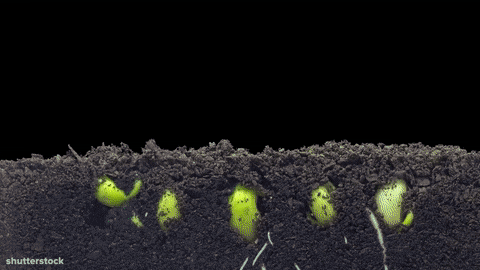
Biology 2

Plant Kingdom: Seed Observation Lab
Purpose
The purpose of this activity is to examine the seed structure and development of the monocot and dicot seeds of several different types of angiosperms. When we are done with this activity you will know what the parts look like, but more importantly where they are found on the seed and the important functions that they perform. We will also be using an indicator solution to help us identify the different parts of the seeds. An indicator solution is any chemical that can detect the presence of another different chemical. Today's indicator is potassium iodide (also known as iodine or Lugol's solution). This indicator will turn dark purple or almost black in the presence of starch. The endosperm of the seeds we will be observing is made of starch so you will see this color change during today's activity.
What Are Seeds?
All seeds contain a little plant called an embryo. Seeds also contain a small amount of food to nourish the embryo. The seed coat protects the embryo until it finds an appropriate place to grow, while the seed leaves, or cotyledons, provide the necessary food energy until roots and true leaves form.
The most common seeds come from flowering plants called angiosperms. The phylum (or division name) for this group is Anthophyta. The most common forms of angiosperms are the two classes: Class Liliopsida (monocots) and Class Magnoliopsida (dicots). Today we will be looking at the lima bean seed, the corn seed, and the peanut seed.
Dicot Seeds
Many of the dicot seeds are familiar to you as "food seeds", or seeds that we eat as food. Some of these "food seeds" are peas, beans, peanuts, and lima beans. The dicot seed is surrounded by a seed coat. This structure provides protection for the entire seed. In some dicots, like the peanut, it is just a very thin membrane, where in others the membrane is quite thick. For today's activity, the lima beans were pre-soaked to soften up this seed coat to make it easier to break apart the seeds.
The dicot seed has two halves and these halves can generally be separated very easily with your fingers. These two halves are called "seed leaves", or more properly, cotyledons. There is ample food stored in the fleshy seed leaves to nourish the new plant until its roots and true leaves are established. Usually, the first two seeds leaves look quite different from the adult leaves, which will develop later. The embryo is composed of the three main parts, the epicotyl, the hypocotyl, and the radicle. The epicotyl is the embryonic shoot that will develop in the true leaves of the adult plant. The epicotyl is sometimes referred to as the "plumule". The hypocotyl will form the stem of the germinating seedling. The radicle is the first organ that appears when the seed germinates. It grows downward into the soil, anchoring the seedling. In angiosperms, the radicle eventually becomes the taproot in the adult plant. On the outside of the seed you will find two additional structures called the hilum and the micropyle. The hilum is a scar that is left by the stalk which attached the ovule to the ovary wall before it developed into the seed. The micropyle is a tiny pore or opening in which the pollen tube entered the seed to deliver the two nuclei during the process of double fertilization. Later when the seed matures and starts to germinate the micropyle serves as a minute pore through which water enters.
See diagrams below to locate the structures of a typical dicot seed.
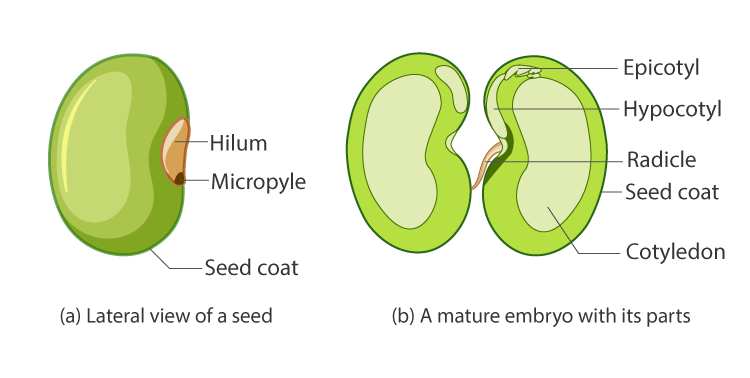
Monocot Seeds
Monocot seeds will not separate into two halves like the dicot seeds. The reason for this is that the embryo is fused to its food source, the endosperm, and cannot be separated. This endosperm is the food source for the embryo and is found surrounding the tiny embryo. Monocots have one seed leaf which is usually long and thin, like grass (only smaller!). One structure that is found in monocots but not dicots is the coleoptile. This structure helps in the emergence of the first leaf and shoot apex by protecting it during its passage through the soil. On emergence, the first leaf breaks through the coleoptile tip. Some common monocot seeds are rice, wheat, barley, corn, coconuts, and grasses.
See the diagrams below of the monocot seeds
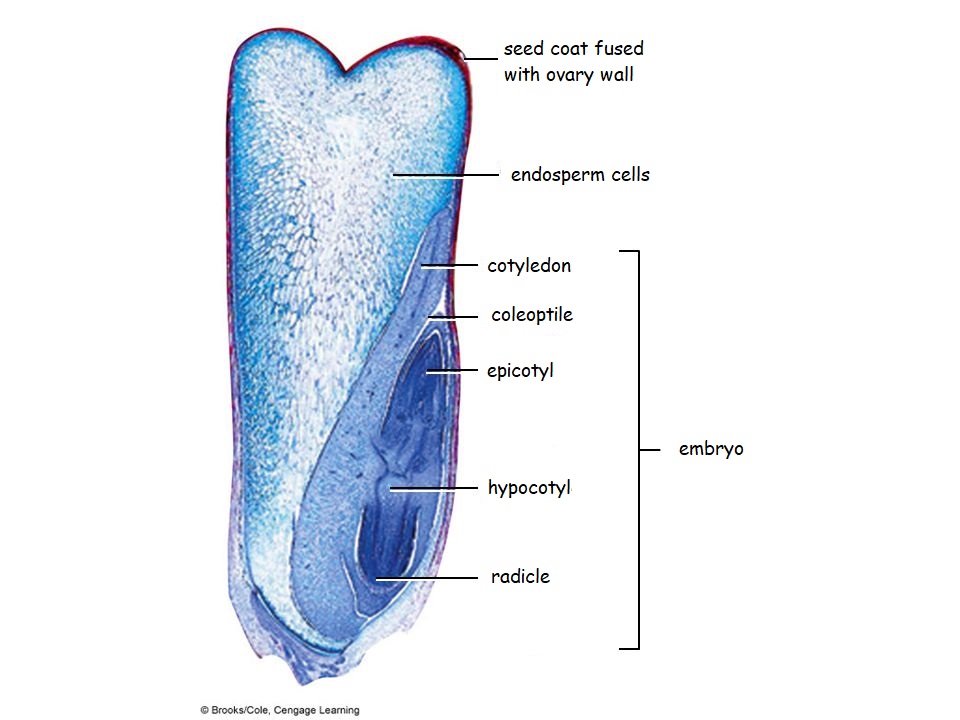
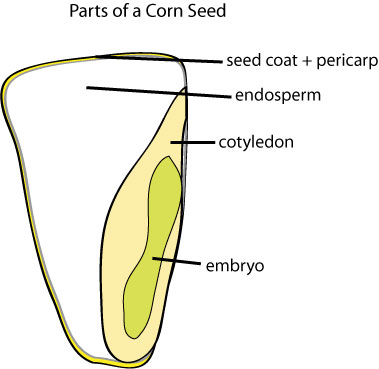
Here are some more diagrams showing monocot and dicot comparisons
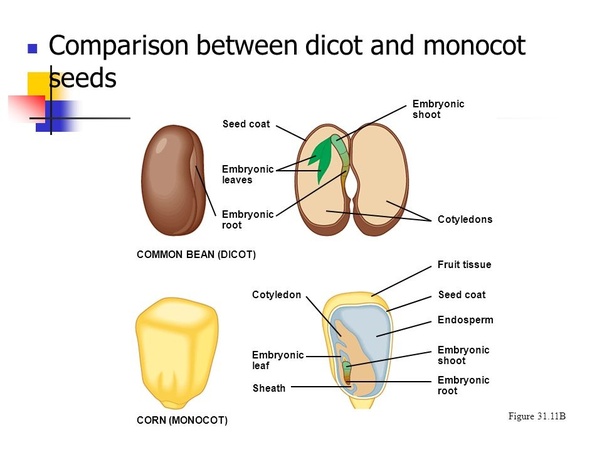

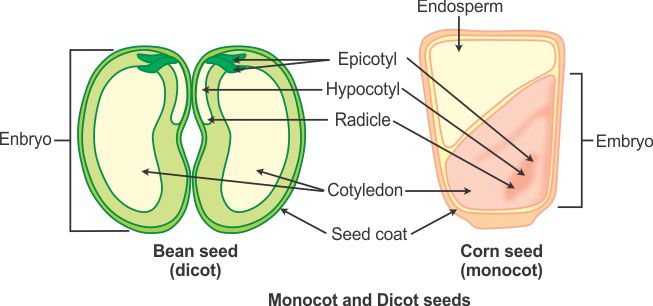
Materials Needed
1. Corn seeds
2. lima bean seeds (pre-soaked to loosen the seed coat)
3. peanuts
4. potassium iodide indicator (iodine)
5. scalpel (or sharp pairing knife)
6. plastic pipette (or eye dropper)
7. dissecting tray (paper plate or paper towels will do for the on-line students)
Corn Seed Dissection
1. Obtain a corn seed and try to break it in half with your fingers.
2. Observe the outside of the corn seed making sure to note the different areas of the seed. (See diagrams below to know what to look for.)
3. View the first 3 minutes of the video below to see how to properly cut the corn seed.
4. Refer to the diagram below to identify the structures you should see in the corn seed.
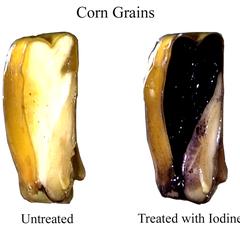
Lima Bean Dissection
1. View the video below (from the 3:15 mark to the 5:15 mark)
2. Refer to the video for directions on how to open the seed and identify the structures within using the iodine.
3. Refer to the diagram below to view the same structures on your lima bean.
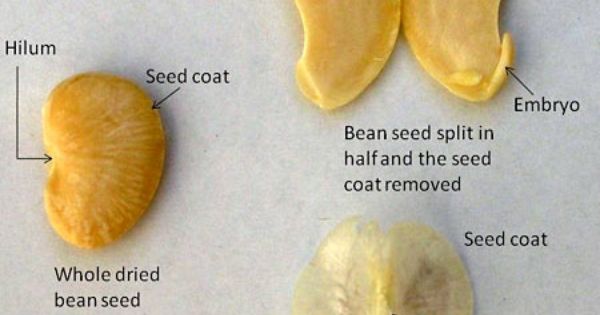
Peanut Seed Dissection
1. Remove the hard outer pod, or hull, by gently cracking it with your fingers. DO NOT use the scalpel or knife for this, it's too round and your blade will slip.
2. Inside should be two (or possibly three) peanut seeds.
3. Remove the thin brown seed coat and gently split the seed into the two cotyledons. Use the diagrams below to identify the parts of the peanut seed.
4. Using a small amount of iodine, stain the young embryo like you did for the lima bean.

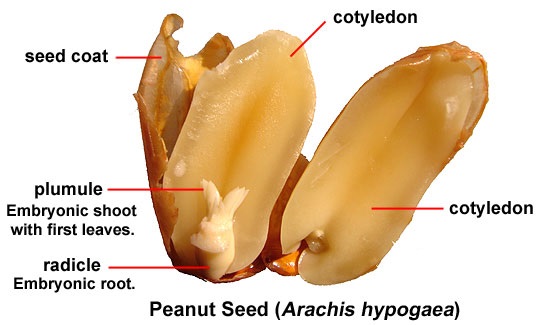
Clean Up
1. Throw away all seeds.
2. Wash and dry the scalpels and trays. On-line students follow your household rules for disposal.
3. Throw away the plastic pipettes. They are contaminated and cannot be reused.
4. Take extra care cleaning the tables, utensils, and trays to eliminate the possibility of peanut residue. Peanut allergies can be extremely dangerous, so do your part to protect these folks.
Assignment
1. Complete the Angiosperm Seed Observation Lab on JupiterEd. Check the Biology 2 website for the exact due date.